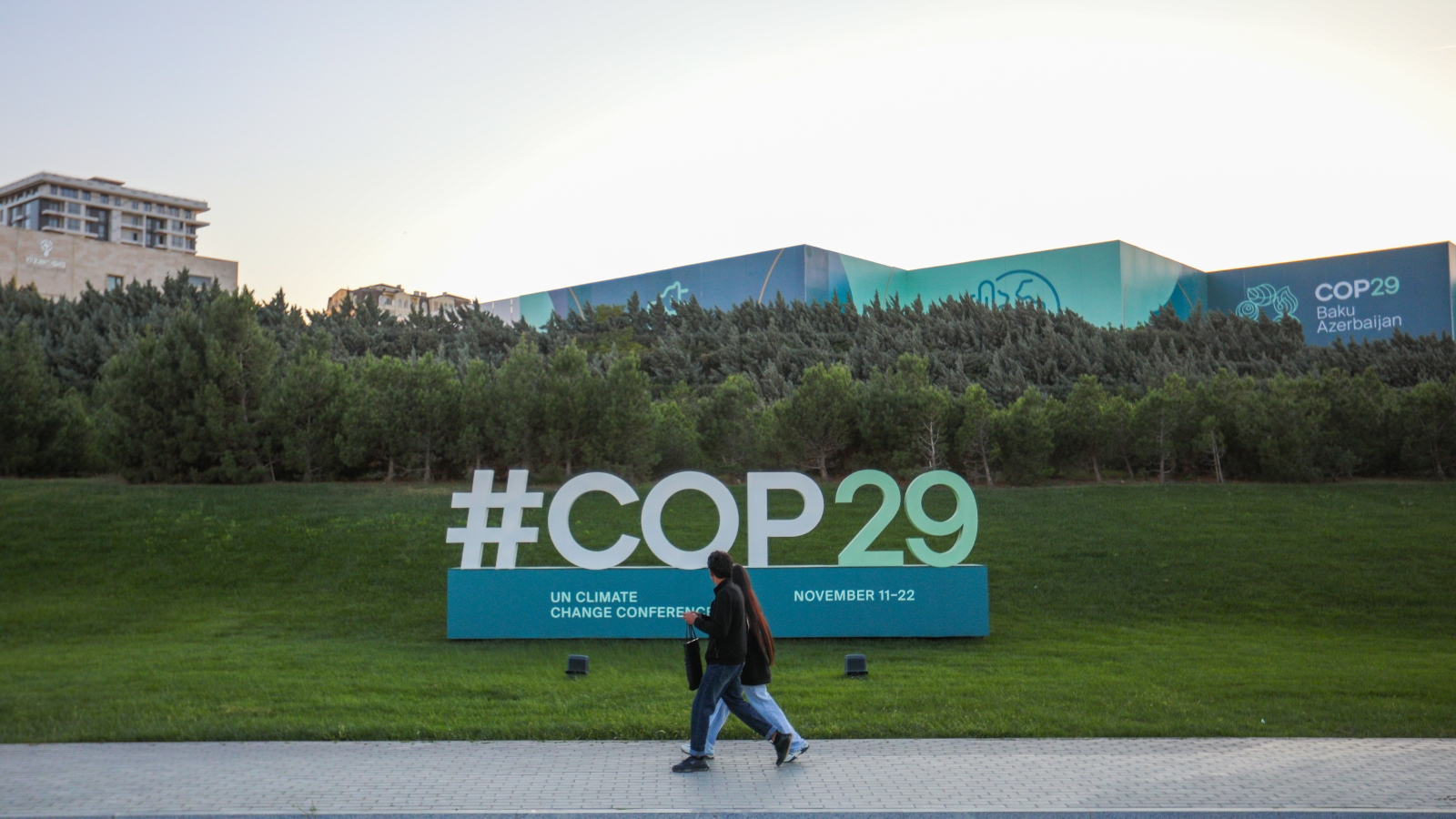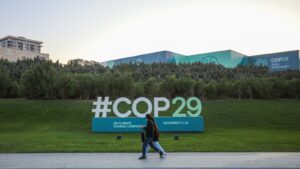
It is possible that there has never been a worse time for the United Nations to hold climate change negotiations. Post-pandemic inflation has pummeled countries around the world, straining public budgets and distracting governments from climate action. Conflicts in Ukraine and the Middle East continue to rage, upsetting the priorities of powerful countries such as Russia, Iran and those of the European Union. To top it all off, the United States just elected Donald Trumpwho called climate change a “hoax” and removed the US from the 2015 Paris climate accord during his first term in office.
Nevertheless, in a few days, thousands of negotiators and activists will gather in Baku, Azerbaijan, to try to make progress on the global climate battle. This year’s conference, known as COP29, is widely recognized as a transitional affair without the marquee significance of the 2015 Paris talks – or even last year’s summit in Dubaiwhich saw the world’s nations finally agree to move away from fossil fuels. Still, next week negotiators plan to hash out key issues that could determine both how the world mitigates carbon emissions and also how it addresses the increasing toll of climate disasters in developing countries.
Here’s what to look out for:
A new goal for international climate aid
The main line agenda item at COP29 is the so-called “new collective quantified goal,” a target that determines how much climate aid money rich countries must send to poorer countries. This funding is supposed to help developing countries switch to renewable energy and adapt to climate effects such as droughts and sea level rise. Negotiations will be tense because rich countries have default on previous obligationsand much of the money they have was sent in the form of expensive loans, or otherwise was of questionable value for the climate fight. All this is on top of the fact that developing countries and many experts claim that the current aid commitments are insufficiently low. A UN report released earlier this week found that adaptation efforts are notably underfunded to the tune of between $180 and $360 billion per year.
“It’s not just about the volume of money,” said Emilie Beauchamp, an advocate at the International Institute for Sustainable Development, a climate-focused think tank. “It’s about whether the finances really reach those who need it the most.”
Negotiators aim to settle on a new goal by the end of COP. Vulnerable nations are pushing for an annual commitment that runs into the trillions of dollars. But there are still key questions about who should put money in, and who should receive it. The United States and Europe called for massive economies like China and rich petrostates like Saudi Arabia to contribute funds even though they were considered “developing” nations when the UN first began negotiating climate change. These countries have resisted these calls, pointing out that the United States and Europe have historically been responsible for more total emissions. This geopolitical deadlock has held up progress in the negotiations for months, and is key to an overall global agreement on climate aid.
Save from the USA
The first few days of each COP feature a parade of announcements from world leaders and their senior ministers, who take the stage to proclaim — and quantify — their country’s commitment to the climate fight. This year’s round of announcements will feature an elephant in the room: The United States, which is the world’s largest economy and its biggest historical emitter, is likely to formally withdraw from the international climate battle once Trump takes office next year. Current President Joe Biden is not attending the COP, and even if his senior administration officials make new promises, it may be difficult for other countries to take them seriously.
The question is whether other major emitters, notably China and the European Union, are increasing their ambition in an attempt to bridge the gap that Trump is likely to create. Ministers from these countries have probably already been preparing for a Trump victory. But with both Europe and China struggling through economic malaise in recent years, it’s unclear how much other governments will be willing to pledge when it comes to clean energy and adaptation investments.
Coordinate the global energy transition
The big news from last year’s COP28 was the “UAE Consensus” document, an agreement in which all the world’s major economies, including the United States and petrostates such as Saudi Arabia, pledged to move away from fossil fuels. Language calling for “switching away from fossil fuels in energy systems, in a fair, orderly and equitable manner,” was carefully crafted, but now it must be put into practice. The summit in Baku is unlikely to see another agreement of this scale, but individual countries will outline more specific commitments they plan to make to move that energy transition forward.
One of the biggest action items is the regulation of methanea greenhouse gas that is orders of magnitude stronger than carbon dioxide. The US, the European Union and Canada have all unveiled sweeping new regulations on methane from oil wells and industrial facilities in recent years, but negotiators at COP are likely to make new progress on curbing methane from agriculture, which accounts for about a third of global emissions of the gas.
“A few years ago [agriculture] was kind of the third trace of methane — you didn’t want to touch it because the politics around it were so, so bad,” said Jonathan Banks, a senior policy adviser at the Clean Air Task Force, referring to pushback from farmers in states such as the Netherlands. “But we turned to agriculture.”
There will also be major debates over the role of nuclear energy, which has attracted renewed interest in recent years from countries looking for carbon-free power, as well as carbon capture and storage technology, which the oil industry touts as a important way to reduce emissions. There are strong disagreements both within and between countries about whether these technologies are climate solutions or not; a line in last year’s COP28 agreement, which suggested coal power could be used for decades as long as it was accompanied by carbon sequestration, sparked strong objections from some negotiators.
Carry out climate restoration
Two years ago, longtime rich nations promised to provide what was coming down recovery for their role in causing climate change. Because these early-industrializing nations historically emitted the most greenhouse gases, the argument goes, they should send money to poor countries to help them recover from climate-driven disasters that the latter did little to cause. This commitment was the realization of a claim that small island states and developing countries in Africa had been seeking for years.
But the devil is in the details: The new “loss and damage” fund is housed at the World Bank, which is a difficult legacy with developing countries, and rich nations only capitalizing the new fund to the amount of $700 million, a fraction of the total need. The big question at this year’s COP is whether or not this fund can get off the ground bogged down in bureaucracy that it fails to meet the challenges faced by the countries it was meant to help.
Fighting over carbon markets
One of the main ways large companies claim progress towards their emission reduction targets is through what is known as the voluntary carbon market. It works like this: When climate pollution is too difficult or too expensive to reduce directly, a company can simply buy credits that prevent or represent sequestered emissions elsewhere (say through an afforestation project that promises to keep carbon locked up in the trunks of newly planted trees ). Now the United Nations is trying to create its own carbon market – but for countries, not companies. The aim is to give nations more ways to work together to achieve their Paris Agreement targets.
Some experts say such a market could speed up global emission reductions and reduce the cost of climate mitigation. But the issue is highly contentious, and environmental groups worry that a UN-backed carbon market would repeating the same shortcomings such as those seen in voluntary markets. Some scientists have criticized carbon markets for legitimizing “rubbish” offset it don’t keep carbon out of the atmosphere permanentlyor it’s going to happen anyway.
By last year’s COPdiplomats no progress made on the development of the UN carbon market at all, differ on the types of carbon credits that should be eligible for trading and on the methodologies used to generate them. This year’s COP president promised to get the market “to the finish line”, but there are differences of opinion likely to continue. Some commentators say Trump’s re-election has “enthusiasm dampened“for a strong outcome.
Joseph Winters contributed reporting to this article.





